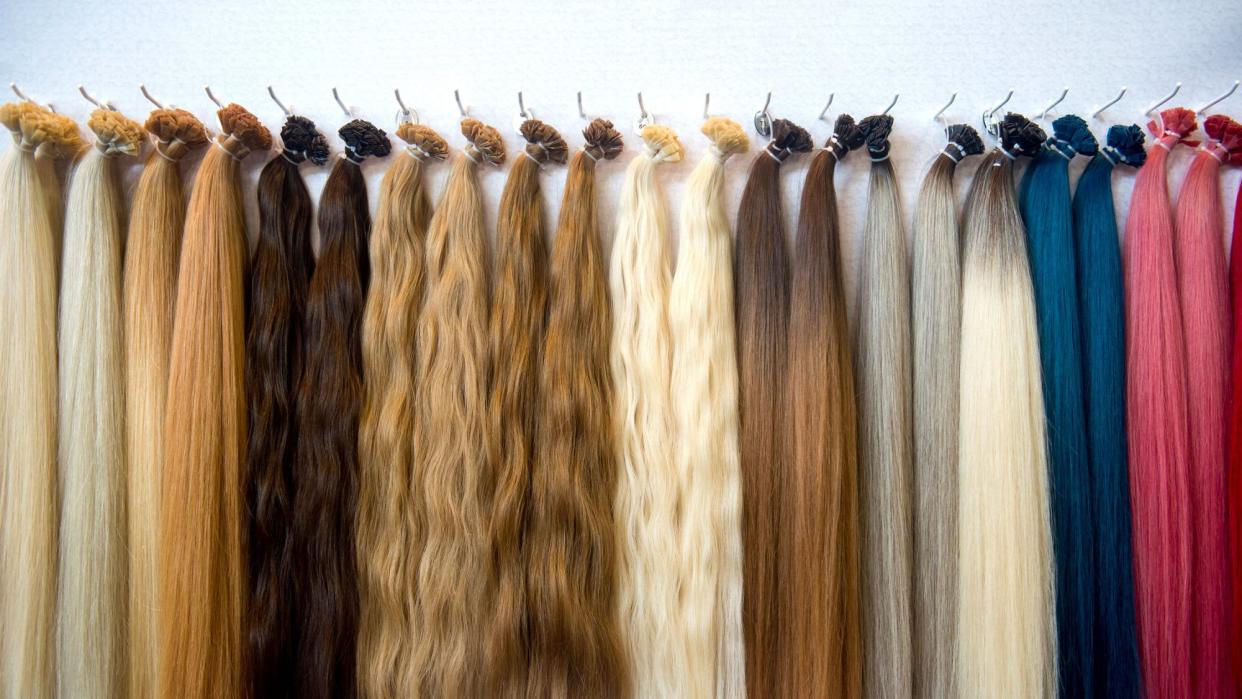Can You Make Your Own Wig At Home Without Losing Your Mind?

Getty Images
Whether you've ventured back into the salon, or you're still doing your own hair at home, styling has become a hassle — especially if you're someone who enjoys switching up their look on the regular.
But, that's why wigs exist. And if you're feeling uneasy about trying anything on in person or just haven't found a hair piece that really suits you, the good news is that making your own custom wig at home isn't as hard as it may seem. Just ask master stylists Kiyah Wright and Tamika Gibson.
"With the proper guidance a beginner can make an amazing wig for themselves," Gibson says. "Plus, you can be as detailed as you'd like without paying the extra price."
"You also have the ability to color the hair first, so every piece of the wig is complete before putting all the pieces together," Wright adds.
And this is exactly why I came to you.
Find out everything you need to know about making your own wig, right in the comfort of your own home.
RELATED: Black Women's Deep Relationship With Wigs Isn't What You Think It Is
What Products and Tools Will I Need to Make a Wig?
I'm not going to lie, you will need quite a few tools to get started. But the good news is that you might already have some of these things at home.
Wright recommends having a wig stand, which she says is "great for stability when you begin assembling your wig," as well as I, J, and C-shape needles to weave in the tracks, thread, T-pins, U-shape wig clips, wig combs, sewing scissors, a hair comb, hair clips, a mesh net wig cap, bundles of hair, a few hours of spare time, and of course, a mannequin head.
"[I recommend] the canvas kind because it's a blank head," says Wright. "They also come in different sizes: small medium, and large. I would advise you to measure your head first before buying."
Gibson adds that it also doesn't hurt to have a sewing machine on deck, and advises using two to three bundles of hair, along with your choice of a closure or frontal.
VIDEO: Taraji P. Henson's Hair Is Now Longer Than Ever Before
What Steps Do I Need to Follow to Create the Wig?
Step 1: Pick the Lace Cap and Hair
Be mindful that the lace cap should match the color and general look of your scalp, so you may want to avoid going for something with patterned stitching. In terms of hair, the choice is up to you, but it's always a good idea to get high-quality hair, so you can keep your wig for years to come.
Step 2: Form the Wig Foundation
"Use the net cap and place it on your mannequin head," says Wright. "Also, add an elastic strap at the end for extra security."
Step 3: Prep the Hair
"Prepare your hair extensions by measuring and cutting the extensions to fit the circumference of the wig cap," Wright suggests.
Step 4: Start Sewing
"I like to stitch my frontal or closure on first by hand, then secure it with the machine," says Gibson. However, she adds you can also add it in afterward. Just make sure to trace out the area first.
When it comes to the tracks, Wright recommends sewing them into the wig cap in a U-shape, starting at the back. You can do this by hand or by using a sewing machine. Gibson prefers the latter.
RELATED: Welcome to Shea Couleé's Wonderful World of Wigs
"The sewing machine makes my wigs last one to three years," she shares. "I start adding the tracks from left to right. You can fold over or cut the weft securing it with the machine to prevent shedding."
If you want to make the hair appear thicker, the stylist recommends double stitching the wefts (or tracks) together. Once you're done, style your wig as desired.
Watch Wright break down the process in the video below.
You can also sign up for wig-making classes with Gibson if you want to take your hair to the next level.
What Do I Need to Know About Wig Care?
"Be sure you have a mannequin stand and mannequin head," Wright advises. "You should also have a wig box to carry your hair in when traveling, in particular something silky. I personally like to take my wig off every day to reduce the wear and tear on it."
When it comes to cleansing, Gibson says you need to be extra gentle. "During shampooing, do not stretch the wig in the process. Handle with care." Otherwise, it may no longer fit properly after a few wash days.
This is All Natural. From the kinkiest coils to loose waves, we're celebrating natural hair in its many forms by sharing expert tips for styling, maintenance, and haircare.


